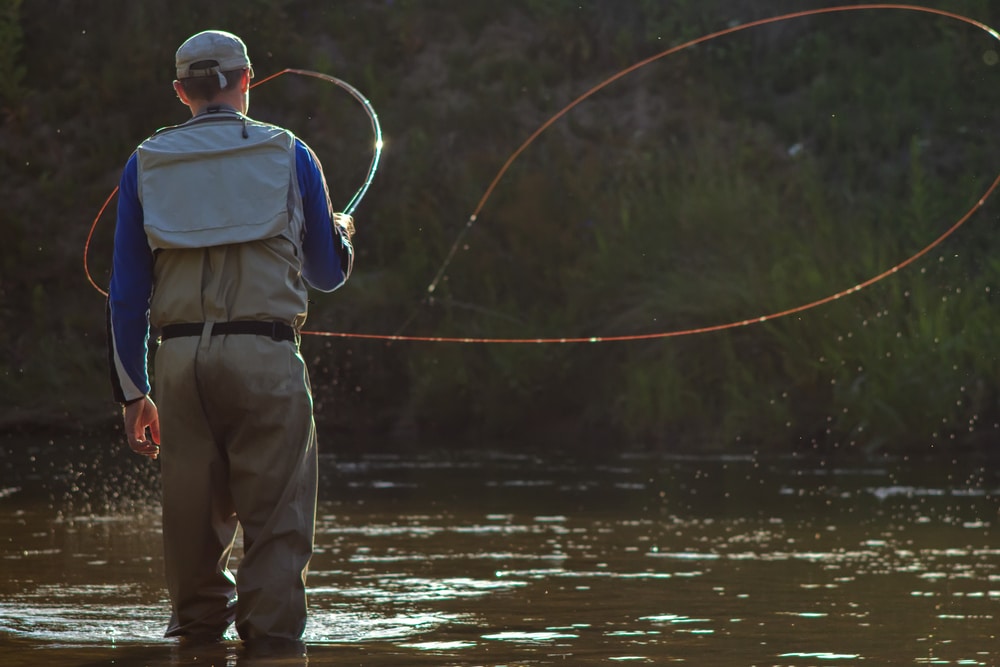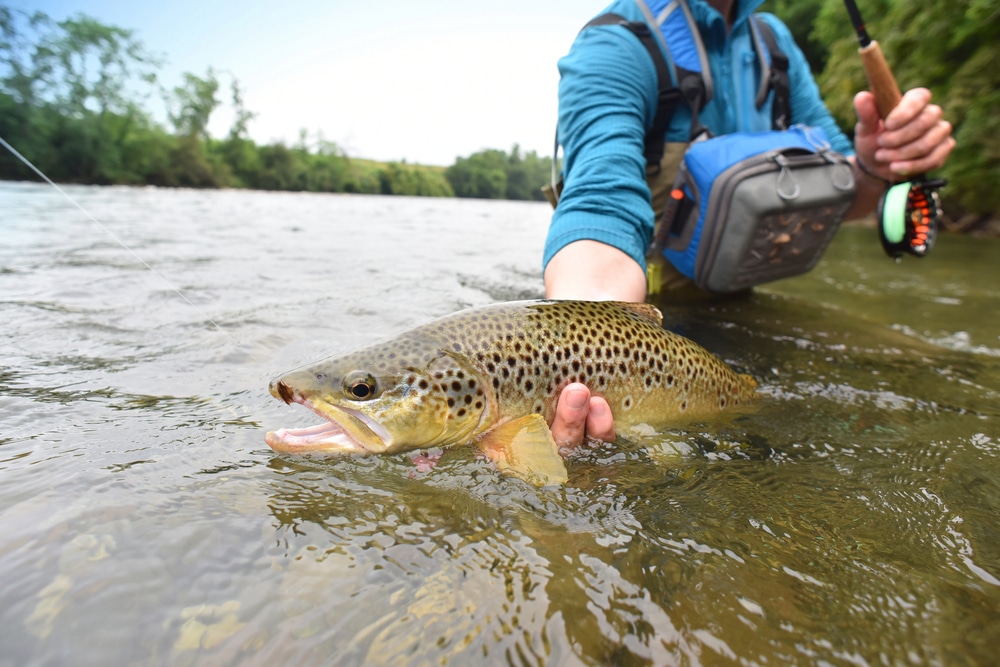For most trout fishing, you would want a fly rod that is a 4 weight, 5 weight, or 6 weight.
The weight of the rod basically means the pound test weight of the line that you use.
You want a six-weight rod for bigger trout, like fat Brown Trout or Rainbows.
A four-weight or five-weight is ideal for smaller trout such as brook trout or cutthroat trout.
If you know what kind of trout you want to fish for, then you can buy a fly rod that fits that species.
If you want an all-around fly rod that can target many trout species, go for a five-weight fly rod in the nine-foot range.

Contents
How do I choose a fly rod weight?
The weight rating on a fly rod correlates to the maximum line weight the rod will hold.
A four-weight fly rod holds 4-5 pound test line. A six-weight fly rod holds a 5-6 pound test line – sometimes a seven-pound test if you want to push it.
This is important because a fly rod’s reel holds backing (line) plus regular line, and the higher the pound test of the line, the thicker it is in diameter.
That means a fly reel will hold less line if the line is higher in pound test rating.
Another reason that line weight is important on a fly rod is that the rod is made to cast a specific weight of the fly line.
Fly-fishing rods do not need a sinker. The weight of the fly is what causes the line to fly.
If you match the weight of the line to the weight of the rod, you end up with what we anglers call a balanced set.
If you drop the weight of the line by one to the weight of the rod, you gain a bit of advantage.
The lighter line presents on the water more smoothly and lightly, which can be a good thing when targeting wild or frightened fish.
So, it is better to go down a line weight in comparison to the rod weight for most applications.
The exception to this is when you fish in the wind.
It can blow a lighter-weight line off course if the wind is stronger.
In the wind, you fish with a heavier line. Go up one weight in line for windy conditions.

How location plays a role in line weight selection
You want to choose different line weights for your fly rod in certain situations or locations.
Small Creeks – You choose smaller line weights when you fish in smaller creeks with narrow channels. Generally, we are talking line weights in the 1-3 weight range. The lighter weight line is more accurate to cast. You are also likely to find tiny trout or fish in these streams.
Small to medium creeks – You can go with a four-line weight in smallish-medium streams. You won’t need to cast as far, and you will encounter larger fish than those in the smaller creeks.
Most Versatile Line Weight – If you do not know what line weight you need, you go with a five-weight line. It is the most applicable line weight for fly rods. Five weight line works well for smaller bass and trout and in rivers that are larger than creeks.
Bigger Holes, Rivers, and Fast Flowing Water – a six-weight line is good for bigger fish like rainbow trout, brown trout, and the waters in which you find them. These are often rivers rather than creeks. For smaller trout in smaller creeks, you’d choose a line weight range of 1-4.
Fast-moving rivers, large rivers where you find trophy fish – A line weight seven is what you use when you target Salmon and, big trout, big bass. These fish are often found in bigger rivers with fast-flowing waters.
Saltwater Fish – Line weight eight is what you use for inshore and nearshore saltwater fishing. You would also use a line weight eight-line for big Salmon.
FAQ
Can you use a 6 weight fly rod for trout?
Yes. You can use a 6 weight fly rod for trout.
A 6-weight fly rod is good for bigger trout, such as rainbow trout and bull trout.
It is even a good option for smaller saltwater fish, such as perch and spotted sea bass.
You can also drop the line weight on a 6-weight rod to a line weight of five-weight and enjoy an expanded set of locations and fish that you can target.
Is a 5-wt fly rod good for trout?
Yes. You can fish most trout species with a five-weight fly rod.
You can also target other species of fish such as bass, carp, and bluegill with a five-weight fly rod.
The 5-weight fly rod is the most versatile fly rod you will find. If you can only have one fly rod, go for the 5 weight.
You will get the most opportunity from it.
Difference between a 5 and 6 weight fly rod in application
The basic difference between a 5-weight fly rod and a 6-weight fly rod is the size of the fly it can handle.
Five-weight fly rods are masters of tossing dry flies and that means excellent trout and bass fishing with these rods.
A 6-weight fly rod is crafted to handle heavier dry flies and wet flies.
Keep in mind that a fly rod does not need a sinker. It is the weight of the fly that matters, and that is why you pair the weight of the fly to the weight of the rod.
Generally, a 5-weight fly rod is ideal for dry flies, whereas a 6-weight fly rod will handle bigger dry flies, nymphs, and streamers.
These are flies that tend to target bigger fish, such as trophy Rainbow Trout, Brown Trout, Lake Trout, and smaller salmon.
Can you use a 7-weight fly rod for trout?
Yes, you can use a 7-weight fly rod for trout fishing.
You will want to target larger trout, such as rainbow trout, brown trout, and lake trout, over smaller trout species such as brook trout and cutthroat trout.
You can also use a 7-weight fly rod for bass and steelhead and for saltwater fish such as spotted sea bass.
Is 7wt too big for trout?
A 7-weight fly rod is too big for smaller species of trout, such as cutthroat and brook trout, but it is perfect for larger brown trout, rainbow trout, steelhead, bass, and even pink salmon.
Final thoughts
The best advice to give in regard to line weight and fly rod weight is always to balance the two.
A balanced fly rod line weight setup will afford you more security in catching, playing, and landing fish.
If you are going to fish in specific types of rivers, then set up a fly rod for those rivers along with the matching line weight.
For most fly fishermen, the argument over line weight only gets crazy when you have a bunch of rods to choose from when you leave to go fishing.
The big thing to remember is that you can go up one tick in line weight when fishing in the wind and down one tick in lightweight when fishing for smaller fish.
The rest is best kept at a balance and from there you will find more joy in fly-fishing.







